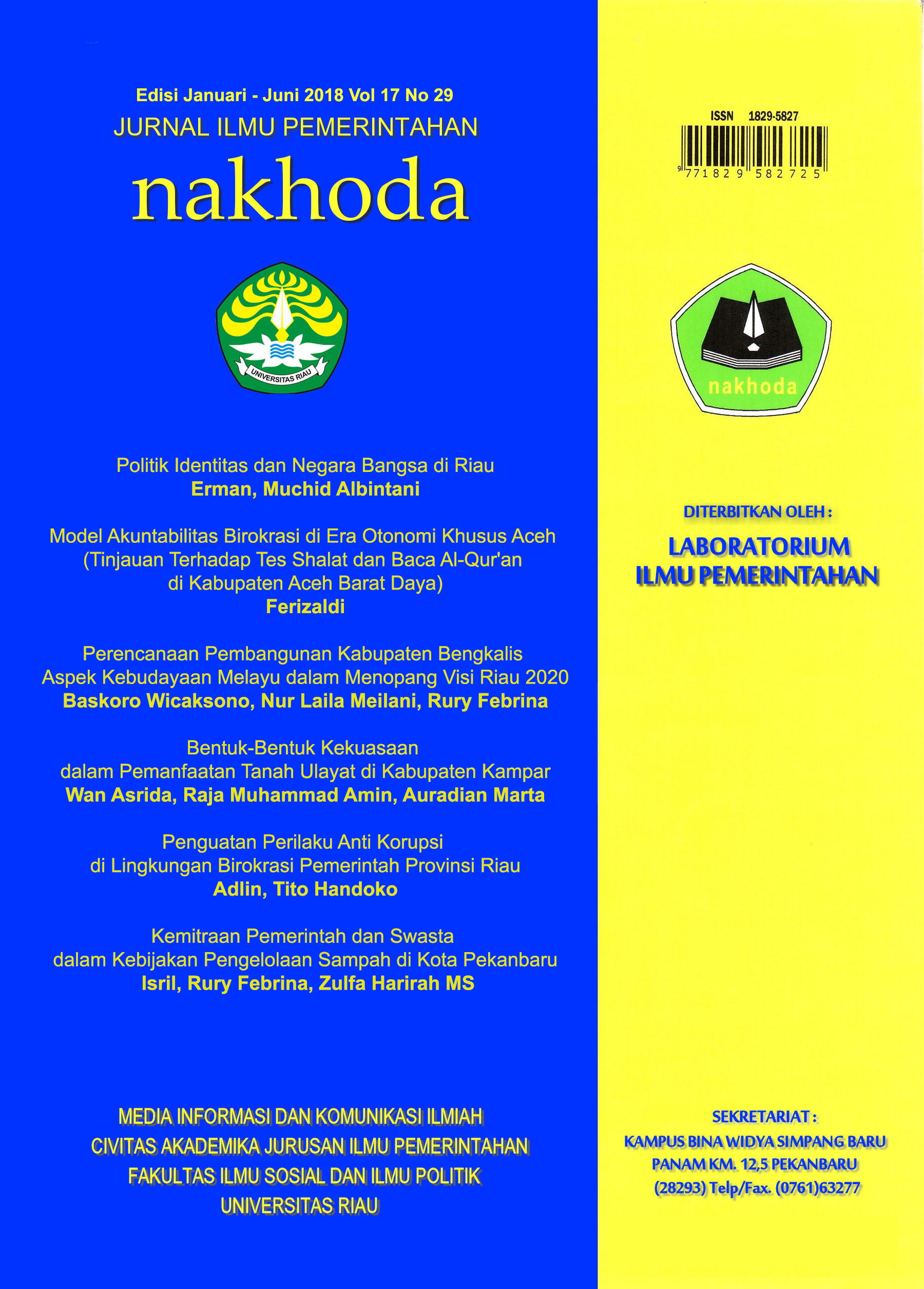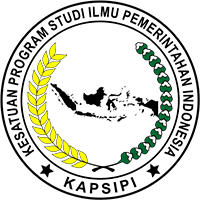Bentuk-bentuk Kekuasaan dalam Pemanfaatan Tanah Ulayat di Kabupaten Kampar
DOI:
https://doi.org/10.35967/jipn.v17i29.7057Keywords:
form of power, communal land, conflictAbstract
This research attempts to analyze the forms of power in the utilization of communal land in Kampar Regency. The interests of indigenous peoples in terms of ulayat land tenure feel threatened by the existence of plantation corporations by bringing large investments which ultimately provide economic added value for the Government and Regional Government. This study uses qualitative research methods with a phenomenological approach. Data was obtained through interviews conducted with elements of the Kampar District Government, Lembaga Adat Kampar (LAK), the Archipelago Indigenous Peoples Alliance (AMAN) Kampar, and traditional leaders. Technical data analysis in this study was conducted interactively. The argument from this study shows that there are 2 (two) forms of power that influence the implementation of ulayat land use in Kampar Regency. The first is visible power, where the practice of power occurs in the formal sphere in the policy-making process of recognizing and protecting customary law communities in Kampar District. In addition, the practice of visible power is also evident from the interaction between actors in resolving communal land conflicts that occurred in Kampar District. While the second form of power in the utilization of communal land is hidden power. This hidden power practice is carried out by corporate actors who are suspected of taking over customary land by playing their power in licenses issued by the Government.
Downloads
References
Creswell, John W. (2014). Research design: qualitative, quantitative, and mixed methods approaches 4th ed. Los Angeles, London. New Delhi, Singapore, Washington DC: SAGE Publications
Halim, Abd. (2014). Politik Lokal Pola, Aktor dan Alur Dramatikalnya. Yogyakarta: Lembaga Pengkajian Pembangunan Bangsa (LP2B).
Knoke, D. (1994). Political networks: the structural perspective (Vol. 4). Cambridge University Press.
Kothari, C.R. (2004). Research Methodology Methods & Techniques Second Revision Edition. New Delhi: New Age International (P) Limited Publishers
Miles, M. B., Huberman, A. M., & Saldana, J. (2014). Qualitative data analysis: A method sourcebook. CA, US: Sage Publications.
Sumardjono, M. S. (2008). Tanah dalam perspektif hak ekonomi, sosial, dan budaya. Penerbit Buku Kompas.
Abubakar, L. (2013). Revitalisasi Hukum Adat Sebagai Sumber Hukum Dalam Membangun Sistem Hukum Indonesia. Jurnal Dinamika Hukum, 13(2), 319-331.
Bakker, L. (2008). “Can We Get Hak Ulayat?”: Land and Community in Pasir and Nunukan, East Kalimantan. Center for Southeast Asia Studies.
Bauer, K. (2015). Land versus Territory: Evaluating Indigenous Land Policy for the Mapuche in Chile. Journal of Agrarian Change 16 (4): 627–645.
Cramb, R. A. (2013). Palmed off: incentive problems with joint-venture schemes for oil palm development on customary land. World Development, 43, 84-99.
Majid Cooke, F. (2012). In the name of poverty alleviation: Experiments with oil palm smallholders and customary land in Sabah, Malaysia. Asia Pacific Viewpoint 53(3): 240-253.
Neves, M. B. C & Machado, M. A. C. (2017). Nationalising indigenous peoples, legalising indigenous lands: a (post) colonial critique of the land demarcation process in Brazil by the analysis of the Guarani-Mbyá case. Postcolonial Studies, 1-14.
Place, F., & Otsuka, K. (2001). Population, tenure, and natural resource management: The case of customary land area in Malawi. Journal of Environmental Economics and Management, 41(1), 13-32.
Suryani, R., & Marta, A. (2016). Interaksi Aktor dalam Penyelesaian Konflik Tanah Ulayat di Kecamatan Tanjung Mutiara Kabupaten Agam Provinsi Sumatera Barat Tahun 2008-2012. Jurnal Online Mahasiswa (JOM) Bidang Ilmu Sosial dan Ilmu Politik, 3(2), 1-12.
Tegnan, H. (2015). Legal pluralism and land administration in West Sumatra: the implementation of the regulations of both local and nagari governments on communal land tenure. The Journal of Legal Pluralism and Unofficial Law, 47(2), 312-323.
Timmer, J. (2010). Being seen like the state: Emulations of legal culture in customary labor and land tenure arrangements in East Kalimantan, Indonesia. American Ethnologist, 37(4), 703-712.
Urano, M. (2014). Impacts of newly liberalised policies on customary land rights of forest dwelling populations: A case study from East Kalimantan, Indonesia. Asia Pacific Viewpoint, 55(1), 6-23.
Yeboah, E., & Shaw, D. (2013). Customary land tenure practices in ghana: examining the relationship with land-use planning delivery. International Development Planning Review, 35(1), 21-39.
Undang-Undang Dasar Negara Republik Indonesia Tahun 1945
Putusan Mahkamah Konstitusi Nomor 35/PUUX/2012
Undang Undang Nomor 5 Tahun 1960 tentang Peraturan Dasar Pokok-Pokok Agraria
Undang-Undang 41 Tahun 1999 tentang Kehutanan sebagaimana telah diubah dengan Undang-Undang 19 Tahun 2004
Peraturan Menteri Lingkungan Hidup dan Kehutanan Republik Indonesia Nomor: P.32/Menlhk-Setjen/2015 tentang Hutan Hak
Peraturan Menteri Lingkungan Hidup dan Kehutanan Republik Indonesia Nomor P.83/MENLHK/SETJEN/KUM.1/10/2016 tentang Perhutanan Sosial
Peraturan Menteri Dalam Negeri Republik Indonesia Nomor 52 Tahun 2014 tentang Pedoman Pengakuan dan Perlindungan Masyarakat Hukum Adat
Peraturan Menteri Agraria dan Tata Ruang Nomor 9 Tahun 2015 tentang Tata Cara Penetapan Hak Komunal atas Tanah Masyarakat Hukum Adat dan Masyarakat yang Berada dalam Kawasan Tertentu
Peraturan Daerah Kabupaten Kampar Nomor 12 Tahun 1999 tentang Hak Tanah Ulayat
Downloads
Published
How to Cite
Issue
Section
License
Copyright (c) 2018 Author(s)

This work is licensed under a Creative Commons Attribution-NonCommercial-ShareAlike 4.0 International License.





